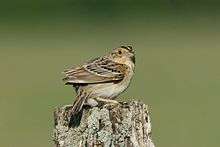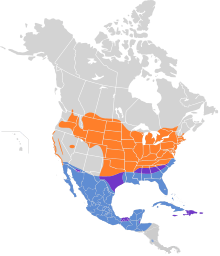Grasshopper sparrow
The grasshopper sparrow (Ammodramus savannarum) is a small American sparrow. The genus Ammodramus contains nine species that inhabit grasslands and prairies.
| Grasshopper sparrow | |
|---|---|
 | |
| Scientific classification | |
| Kingdom: | Animalia |
| Phylum: | Chordata |
| Class: | Aves |
| Order: | Passeriformes |
| Family: | Passerellidae |
| Genus: | Ammodramus |
| Species: | A. savannarum |
| Binomial name | |
| Ammodramus savannarum (Gmelin, 1789) | |
 | |
| Synonyms | |
|
Coturniculus savannarum | |
The Florida grasshopper sparrow (Ammodramus savannarum floridanus) is endangered.
Description
These small sparrows measure 10–14 cm (3.9–5.5 in) in length, span about 17.5 cm (6.9 in) across the wings and weigh from 13.8 to 28.4 g (0.49 to 1.00 oz), with an average of 17 g (0.60 oz).[2][3] Adults have upperparts streaked with brown, grey, black and white; they have a light brown breast, a white belly and a short brown tail. Their face is light brown with an eye ring and a dark brown crown with a central narrow light stripe. There are regional variations in the appearance of this bird.
Distribution and habitat
Their breeding habitat is open fields and prairie across southern Canada, the United States, Mexico and Central America, with a small endangered population in the Andes of Colombia and (perhaps only formerly) Ecuador. The northern populations migrate to the southern United States, Mexico, Central America and the Caribbean. Like many grassland birds, this bird's numbers have declined across many parts of its range, including a 98% drop in New York State.
Behaviour
The nest is a well-concealed open cup on the ground under vegetation. They forage on the ground in vegetation, mainly eating insects, especially grasshoppers, and seeds.
Call
This bird's song is a buzzy tik tuk zee, resembling the sound made by a grasshopper. Unlike some other members of the Ammodramus family of sparrows, they will readily sing from open and exposed perches.
References
- BirdLife International (2012). "Ammodramus savannarum". IUCN Red List of Threatened Species. 2012. Retrieved 26 November 2013.CS1 maint: ref=harv (link)
- "Grasshopper Sparrow Fact Sheet". New York State Department of Environmental Conservation.
- Dunning Jr., John B., ed. (1992). CRC Handbook of Avian Body Masses. CRC Press. ISBN 978-0849342585.
External links
| Wikimedia Commons has media related to Ammodramus savannarum. |
| Wikispecies has information related to Ammodramus savannarum |
- Grasshopper sparrow Species Account - Cornell Lab of Ornithology
- Grasshopper sparrow - Ammodramus savannarum - USGS Patuxent Bird Identification InfoCenter
- Grasshopper sparrow photo gallery at VIREO (Drexel University)
- BirdLife species factsheet for Ammodramus savannarum
- "Ammodramus savannarum". Avibase.

- "Grasshopper sparrow media". Internet Bird Collection.
- Interactive range map of Ammodramus savannarum at IUCN Red List maps
- Audio recordings of Grasshopper sparrow on Xeno-canto.
